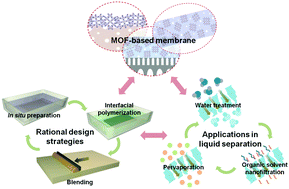当前位置:
X-MOL 学术
›
Chem. Soc. Rev.
›
论文详情
Our official English website, www.x-mol.net, welcomes your feedback! (Note: you will need to create a separate account there.)
Metal–organic frameworks based membranes for liquid separation
Chemical Society Reviews ( IF 46.2 ) Pub Date : 2017-11-07 00:00:00 , DOI: 10.1039/c7cs00575j Xin Li 1, 2, 3, 4, 5 , Yuxin Liu 1, 2, 3, 4, 5 , Jing Wang 6, 7, 8, 9 , Jorge Gascon 10, 11, 12, 13, 14 , Jiansheng Li 1, 2, 3, 4, 5 , Bart Van der Bruggen 6, 7, 8, 9, 15
Chemical Society Reviews ( IF 46.2 ) Pub Date : 2017-11-07 00:00:00 , DOI: 10.1039/c7cs00575j Xin Li 1, 2, 3, 4, 5 , Yuxin Liu 1, 2, 3, 4, 5 , Jing Wang 6, 7, 8, 9 , Jorge Gascon 10, 11, 12, 13, 14 , Jiansheng Li 1, 2, 3, 4, 5 , Bart Van der Bruggen 6, 7, 8, 9, 15
Affiliation

|
Metal–organic frameworks (MOFs) represent a fascinating class of solid crystalline materials which can be self-assembled in a straightforward manner by the coordination of metal ions or clusters with organic ligands. Owing to their intrinsic porous characteristics, unique chemical versatility and abundant functionalities, MOFs have received substantial attention for diverse industrial applications, including membrane separation. Exciting research activities ranging from fabrication strategies to separation applications of MOF-based membranes have appeared. Inspired by the marvelous achievements of MOF-based membranes in gas separations, liquid separations are also being explored for the purpose of constructing continuous MOFs membranes or MOF-based mixed matrix membranes. Although these are in an emerging stage of vigorous development, most efforts are directed towards improving the liquid separation efficiency with well-designed MOF-based membranes. Therefore, as an increasing trend in membrane separation, the field of MOF-based membranes for liquid separation is highlighted in this review. The criteria for judicious selection of MOFs in fabricating MOF-based membranes are given. Special attention is paid to rational design strategies for MOF-based membranes, along with the latest application progress in the area of liquid separations, such as pervaporation, water treatment, and organic solvent nanofiltration. Moreover, some attractive dual-function applications of MOF-based membranes in the removal of micropollutants, degradation, and antibacterial activity are also reviewed. Finally, we define the remaining challenges and future opportunities in this field. This Tutorial Review provides an overview and outlook for MOF-based membranes for liquid separations. Further development of MOF-based membranes for liquid separation must consider the demands of strict separation standards and environmental safety for industrial application.
中文翻译:

基于金属有机框架的膜,用于液体分离
金属有机骨架(MOF)代表了一类引人入胜的固体晶体材料,可以通过金属离子或簇与有机配体的配位,以直接的方式自组装。由于其固有的多孔特性,独特的化学多功能性和丰富的功能性,MOF已受到包括膜分离在内的各种工业应用的广泛关注。从制造策略到基于MOF的膜的分离应用的激动人心的研究活动已经出现。受到基于MOF的膜在气体分离中的卓越成就的启发,也正在探索液体分离,以构建连续的MOF膜或基于MOF的混合基质膜。尽管这些正处于蓬勃发展的新兴阶段,经过精心设计的基于MOF的膜,大多数努力都旨在提高液体分离效率。因此,作为膜分离的增长趋势,本综述重点介绍了基于MOF的液体分离膜领域。给出了在制造基于MOF的膜时明智选择MOF的标准。特别注意基于MOF的膜的合理设计策略,以及在液体分离领域的最新应用进展,例如全蒸发,水处理和有机溶剂纳米过滤。此外,还对基于MOF的膜在去除微污染物,降解和抗菌活性方面的一些有吸引力的双重功能应用进行了综述。最后,我们定义了该领域中尚存的挑战和未来的机会。本教程概述提供了基于MOF的液体分离膜的概述和展望。基于MOF的液体分离膜的进一步开发必须考虑严格的分离标准和工业应用环境安全性的要求。
更新日期:2017-11-07
中文翻译:

基于金属有机框架的膜,用于液体分离
金属有机骨架(MOF)代表了一类引人入胜的固体晶体材料,可以通过金属离子或簇与有机配体的配位,以直接的方式自组装。由于其固有的多孔特性,独特的化学多功能性和丰富的功能性,MOF已受到包括膜分离在内的各种工业应用的广泛关注。从制造策略到基于MOF的膜的分离应用的激动人心的研究活动已经出现。受到基于MOF的膜在气体分离中的卓越成就的启发,也正在探索液体分离,以构建连续的MOF膜或基于MOF的混合基质膜。尽管这些正处于蓬勃发展的新兴阶段,经过精心设计的基于MOF的膜,大多数努力都旨在提高液体分离效率。因此,作为膜分离的增长趋势,本综述重点介绍了基于MOF的液体分离膜领域。给出了在制造基于MOF的膜时明智选择MOF的标准。特别注意基于MOF的膜的合理设计策略,以及在液体分离领域的最新应用进展,例如全蒸发,水处理和有机溶剂纳米过滤。此外,还对基于MOF的膜在去除微污染物,降解和抗菌活性方面的一些有吸引力的双重功能应用进行了综述。最后,我们定义了该领域中尚存的挑战和未来的机会。本教程概述提供了基于MOF的液体分离膜的概述和展望。基于MOF的液体分离膜的进一步开发必须考虑严格的分离标准和工业应用环境安全性的要求。


























 京公网安备 11010802027423号
京公网安备 11010802027423号